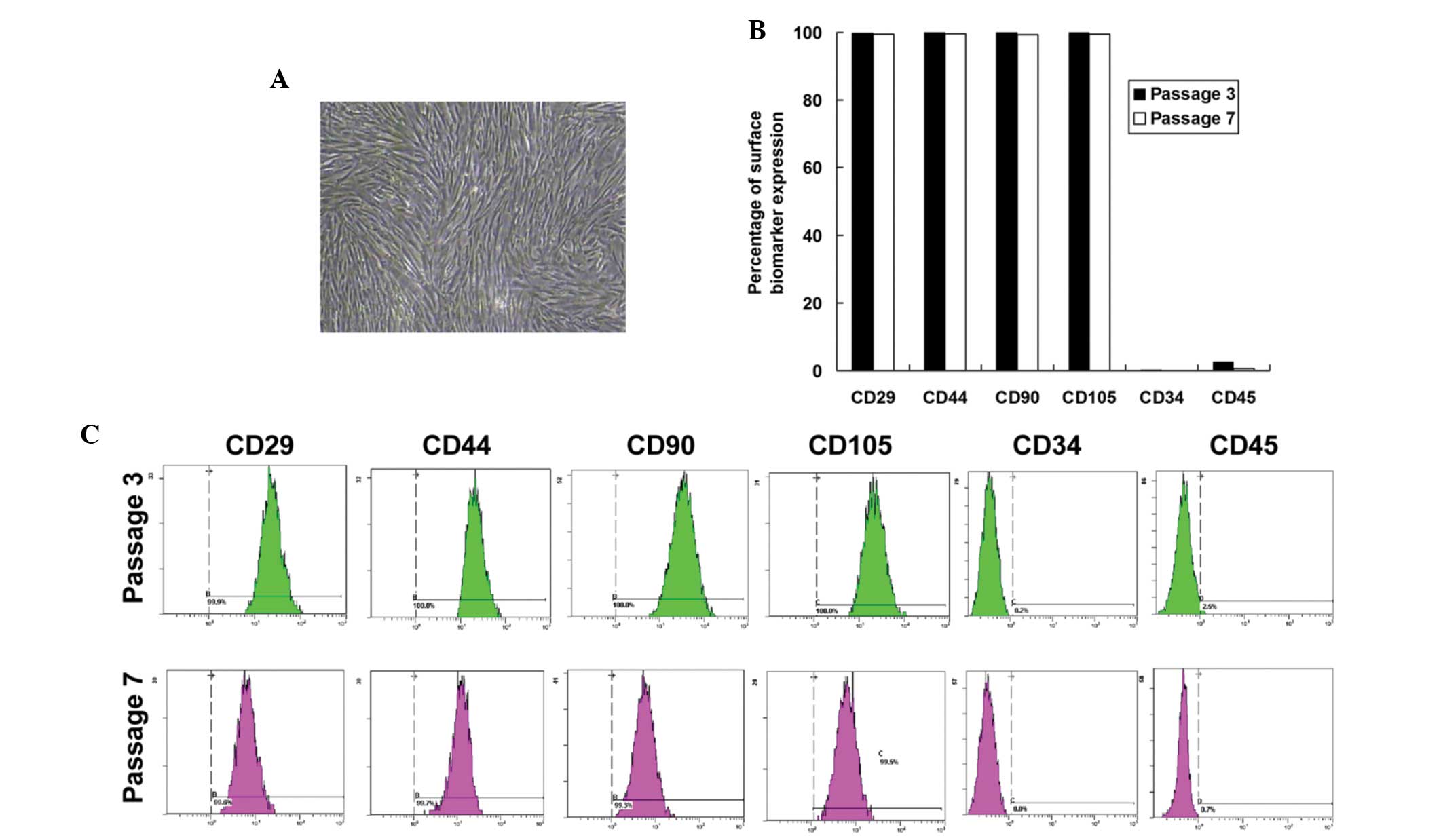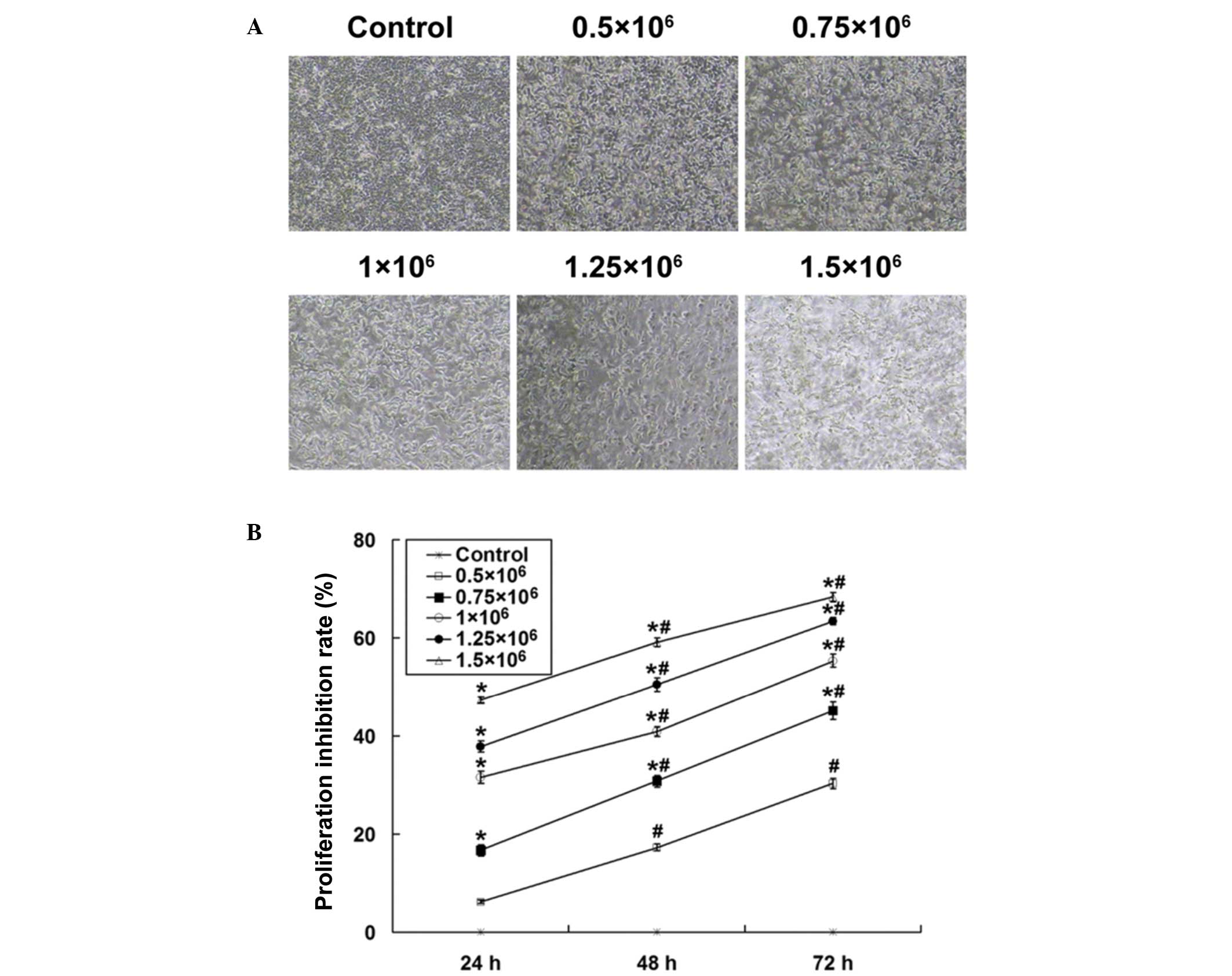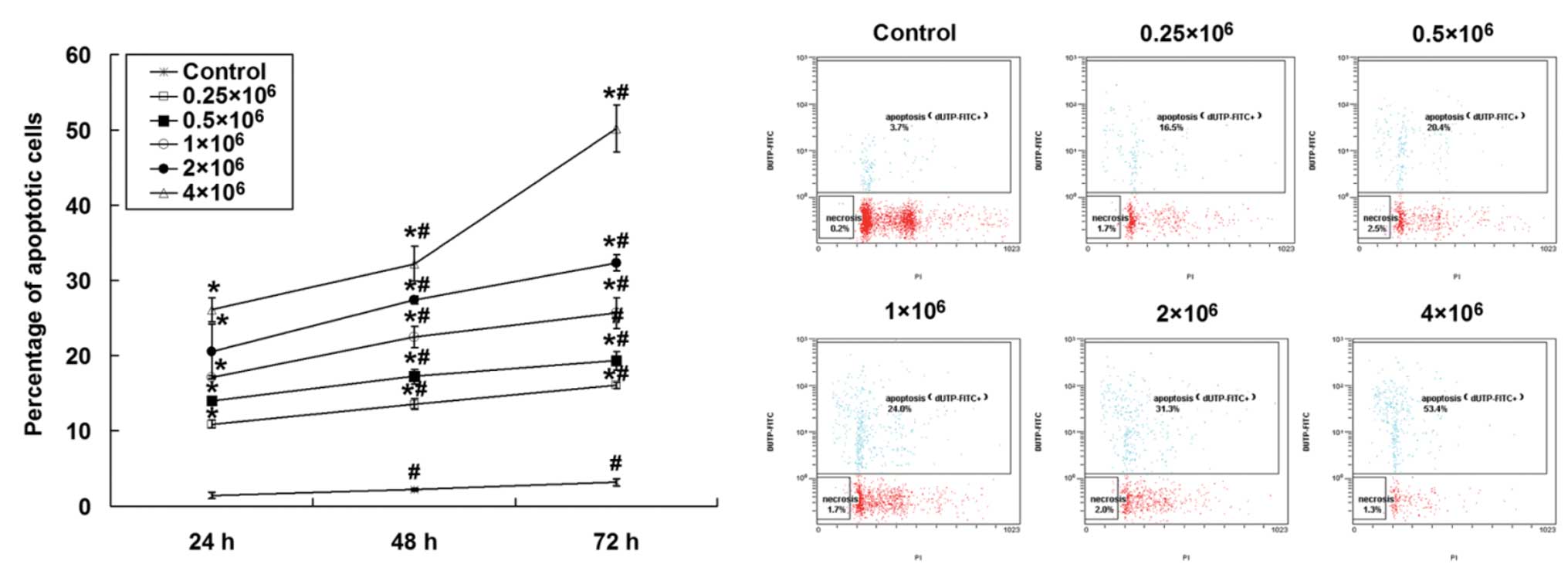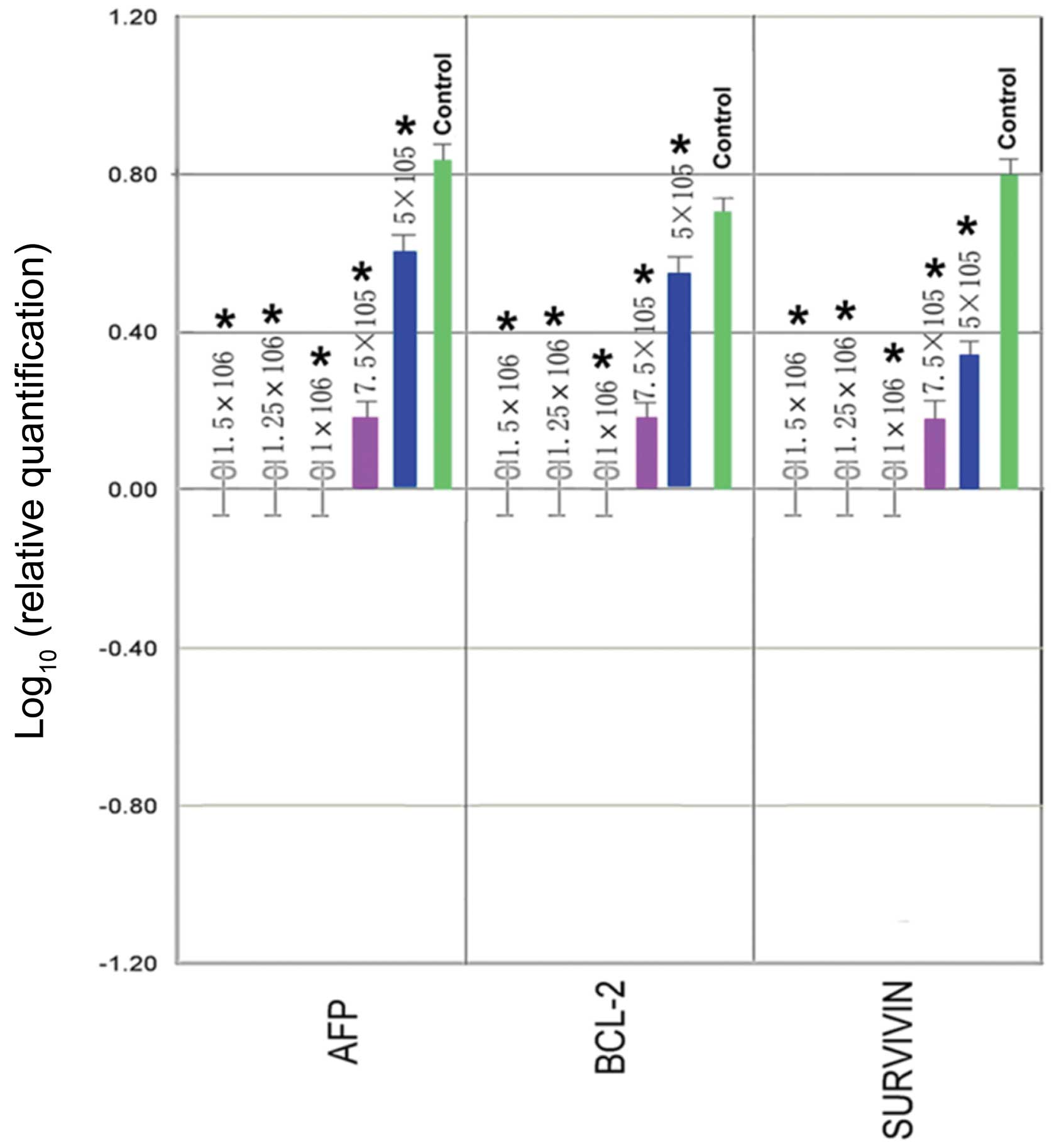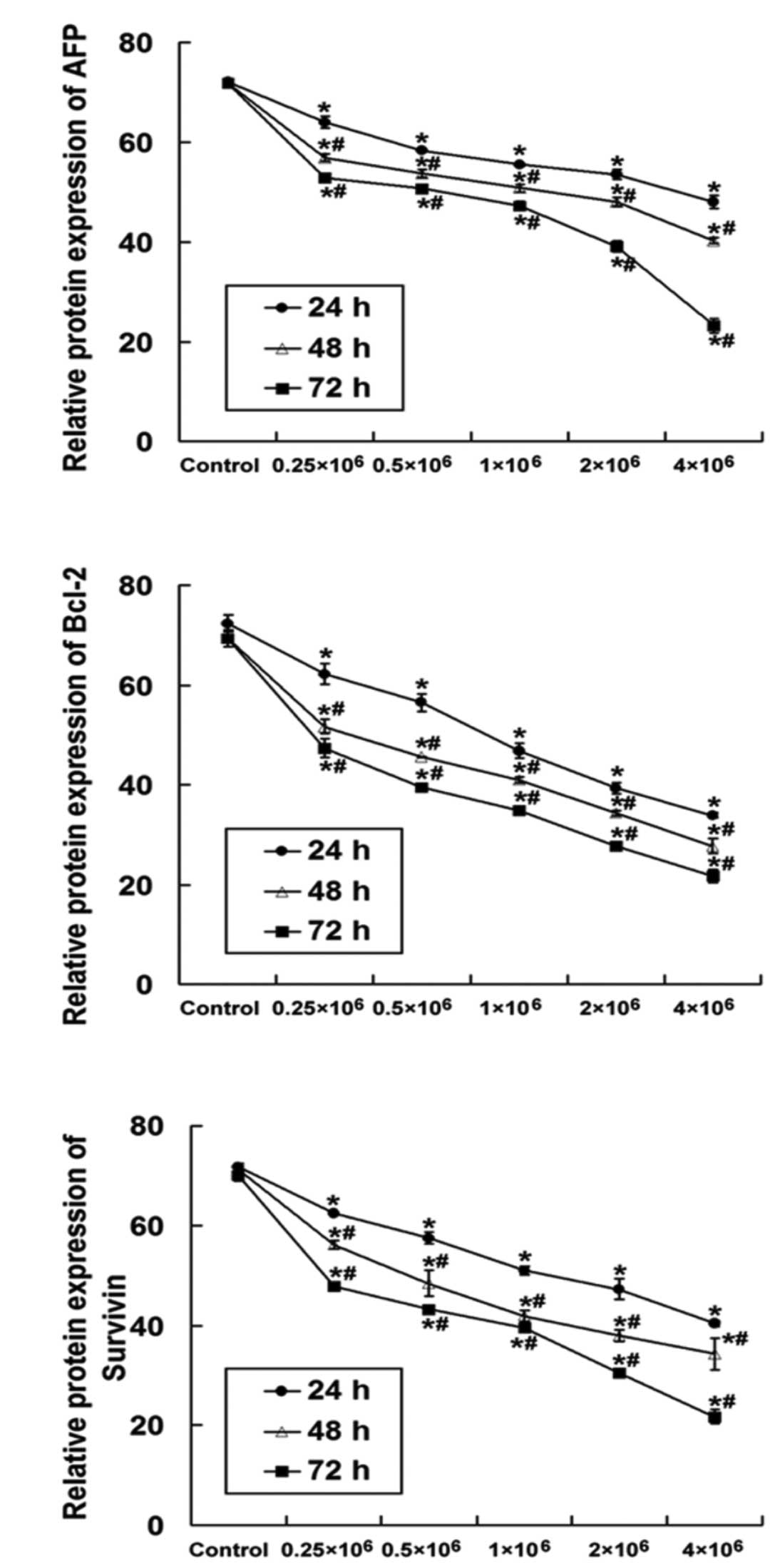Umbilical cord-derived mesenchymal stem cells inhibit growth and promote apoptosis of HepG2 cells
- Authors:
- Published online on: July 21, 2016 https://doi.org/10.3892/mmr.2016.5537
- Pages: 2717-2724
Abstract
Introduction
Hepatocellular carcinoma (HCC), which accounts for 80–90% of primary liver cancer, is the fifth most common type of cancer worldwide and the third most common cause of cancer-related mortality (1). Liver resection is currently the first line of treatment in non-cirrhotic patients, yet the reported overall 5-year survival after HCC liver resection is 30–60%, with a high incidence of recurrence (50–80%) (1–5). Currently, there are no widely accepted chemopreventive strategies to limit the progression of HCC once liver cirrhosis is established (6). Liver transplantation provides a good outcome for patients with HCC meeting the Milan criteria (single nodule ≤5 cm or 2 or three nodules ≤3 cm), and leads to 5-year survival rates of 70% and low recurrence rates (7). The application of liver transplantation is rare, however, due to a limited source of liver donors, high cost and organ rejection following transplantation.
Adult and embryonic hepatocytes, hepatic stem/progenitor cells and extrahepatic stem cells have been used as transplantable cell sources for liver regeneration (8). Such cellular therapy may provide a novel approach for the treatment of advanced stages of HCC. Umbilical cord mesenchymal stem cells (UC-MSCs) are a subgroup of MSCs that possess the potential to differentiate into several mesodermal tissues (bone, cartilage, tendon, muscle and adipose tissue) (9), endodermal tissue (hepatocytes) (10), and ectodermal tissue (neurons) (11,12). However, the effects of MSCs on tumor cells remain controversial. Li et al (13) demonstrated that MSCs enhanced tumor growth but significantly inhibited the invasiveness and metastasis of HCC. However, another group demonstrated that MSCs possess intrinsic antineoplastic properties in a Kaposi's sarcoma model (14). A recent study indicated that human UC-MSCs significantly inhibited the growth of breast cancer stem cells (CSCs) in vitro and in vivo (15).
Based on these data, it was hypothesize that UC-MSCs may have antitumor effects on cancer cells, such as HepG2 HCC cells. The present study investigated the effects of UC-MSCs on HepG2 cells using a Transwell co-culture approach. The results provide valuable insights into the biological characteristics of UC-MSCs and provide evidence for their potential therapeutic use for the treatment of HCC.
Materials and methods
Reagents
Fetal bovine serum (FBS), Dulbecco's modified Eagle's medium (DMEM)/F12, 0.25% trypsin and phosphate-buffered saline (PBS) were purchased from GE Healthcare (Logan, UT, USA). Fluorescein isothiocyanate-conjugated (FITC) mice monoclonal antibodies, including anti-CD29-FITC (cat no. 6604105; 1:50), anti-CD34-FITC (cat. no. IM1870; 1:50), anti-CD44-FITC (cat. no. IM1219U; 1:50), anti-CD45-FITC (cat. no. IM0782U; 1:50), anti-CD90-FITC (cat. no. IM1839U; 1:50), anti-CD105-PE (cat. no. B76299; 1:50), as well as intra-1 (cat. no. A07803; 1:50) and intra-2 (cat. no. A07803; 1:50) were obtained from Beckman Coulter, Inc. (Brea, CA, USA). Monoclonal phycoerythrin (PE)-conjugated antibodies, anti-Bcl-2-PE (cat. no. A15796; 1:50; Invitrogen, Thermo Fisher Scientific, Inc., Waltham, MA, USA) and anti-Survivin-PE (cat. no. 129176; 1:50; eBio-science, Inc., San Diego, CA, USA). Anti-α fetoprotein (AFP) primary antibody and FITC-conjugated IgG (H+L) antibody were provided by LsBio (Seattle, WA, USA) and Invitrogen, Thermo Fisher Scientific Inc., respectively. An RNA extraction kit was purchased from TianGen BioTech Co., Ltd. (Beijing, China). An RNA reverse transcription reaction kit and RNA quantification kit were purchased from Bio-Rad (Hercules, CA, USA). Primers were synthesized by Sangon Biotech Co., Ltd. (Shanghai, China).
Cell culture
Third passage human UC-MSCs were obtained from Beike Biotechnology (Shenzhen, China). These cells were obtained from informed, healthy donors after normal spontaneous vaginal deliveries. The procedure for cell collection and mononuclear cell extraction, cultivation and harvest, has been reported in a previous publication (16). Human HCC HepG2 cells were kindly provided by Professor Lin Wang (17) from the Department of Hepatobiliary Surgery, The 2nd Affiliated Hospital of Kunming Medical University (Kunming, China). UC-MSCs and HepG2 cells were maintained in DMEM/F12 containing 10% FBS, 100 U/ml penicillin and 100 µg/ml streptomycin (GE Healthcare Life Sciences, Logan, UT, USA). Cells were incubated in a 5% CO2-humidified incubator at 37°C. The culture medium was changed every two or three days. When cells reached 80–90% confluency, cell passage was conducted using 0.25% trypsin for digestion. Passage seven to eight UC-MSCs were used for the following experiments.
Co-culture procedure
For co-culture of UC-MSCs with HepG2 cells, a Transwell co-culture system (pore size, 0.4 µm; Corning, Corning, NY, USA) was utilized. UC-MSCs were collected by trypsin digestion, resuspended in fresh culture medium, adjusted to the appropriate cell density (2.5×105–4×106 cells/well) and seeded onto a six-well plate (2 ml cell suspension for each well). After the initial seeding of UC-MSCs (24 h), 1×106 HepG2 cells suspended in 2 ml culture medium were seeded into the upper compartment of the Transwell. Cell morphology was observed under a phase contrast microscopy (BX53, Olympus, Tokyo, Japan).
Flow cytometric analysis of UC-MSC surface biomarkers
Passage three and passage seven UC-MSCs were used for cell identification. Cells were washed with PBS and digested with 0.25% trypsin. After centrifuging at 300 x g for 5 min, the supernatant was removed and cells were washed twice with PBS. Cells were then incubated with FITC-conjugated primary antibodies against CD29, CD34, CD44, CD45, CD90 or CD105 for 30 min at room temperature in the dark. The expression of cell surface biomarkers was determined using flow cytometric analysis. Fluorescence acquisition was performed in a Coulter-EPICS XL flow cytometer (Beckman-Coulter, Inc.) with a 488 nm argon-ion laser.
Evaluation of cell proliferation
After 24, 48 or 72 h of co-culture, HepG2 cells were collected and seeded onto a 96-well plate. Six wells were used for each treatment. Cells were maintained with the culture medium collected from the co-culture system. After 24 h, the co-culture medium was removed and replaced with 180 µl fresh culture medium. Then, 20 µl 3-(4,5-dimethylthiazol-2-yl)-2,5-diphenyltetrazolium bromide (MTT; 5 mg/ml; Beckman-Coulter) was added to each well. After an additional 4 h of incubation at 37°C, the medium was removed and 150 µl dimethyl sulfoxide was added to each well to resuspend the MTT metabolic product. The absorbance of the dissolved formazan was measured at 490 nm (A490) using a scanning microplate spectrophotometer (Bio-Rad). The proliferation inhibition rate was calculated using the following formula: Proliferation inhibition rate = (A490, Control-A490, Sample) / A490, Control × 100.
Measurement of cell apoptosis
Cell apoptosis was measured by flow cytometry and confirmed by terminal deoxynucleotidyl transferase (TdT)-mediated nick end labeling (TUNEL). Using the Transwell system, UC-MSCs were co-cultured with HepG2 cells. A range of initial seeding densities for UC-MSCs was tested (0.25×106, 0.5×106, 1×106, 2×106 or 4×106 cells/well). After co-culture, HepG2 cells were collected and cell density was adjusted to 1×106 cells/ml. After washing with PBS, cells were fixed with 4% paraformaldehyde (Sigma-Aldrich, St. Louis, MO, USA) for 30 min at 4°C. Then, cells were washed with 0.2% bovine serum albumin (BSA; GE Healthcare Life Sciences) in PBS and incubated with 70% ethanol at 20°C for an additional 30 min. After washing twice with 0.2% BSA in PBS, cells were treated with the TdT solution (1.5 µl TdT, 27 µl TdT buffer and 1.5 µl FITC-dUTP; GE Healthcare Life Sciences) or a negative control solution (28.5 µl TdT buffer and 1.5 µl FITC-dUTP) for 1 h at 37°C. After washing, samples were incubated with 20 µl of 10 mg/ml RNase (Sigma-Aldrich) and 20 µl of 0.1% Triton X-100 (Invitrogen; Thermo Fisher Scientific, Inc.) for 15 min at 37°C followed by 100 µg/ml propidium iodide (PI; Sigma-Aldrich) staining for 15–30 min. Fluorescence acquisition and analysis were performed using a flow cytometer (Beckman-Coulter, Inc.).
Reverse transcription-quantitative polymerase chain reaction (RT-qPCR)
UC-MSCs were seeded and co-cultured with HepG2 cells for 72 h with a range of initial seeding densities (0.5×106, 0.75×106, 1×106, 1.25×106 or 1.5×106 cells/well). Total RNA was extracted from HepG2 cells using an RNA extraction kit according to the manufacturer's instructions. RNA concentration and purity were assayed by gel electrophoresis. Total RNA (1 µg) was reverse transcribed using a reverse transcription kit according to the manufacturer's instructions. PCR amplification was conducted with specific primers designed by Primer 5.0 software (PREMIER Biosoft, Palo Alto, CA, USA) as follows: Forward: 5′-TGC GTT TCT CGT TGC TTACA-3′ and reverse: 5′-GCT GCC ATT TTT CTG GTGAT-3′ for AFP; forward: 5′-GTG GAT GAC TGA GTA CCT GAA CC-3′ and reverse: 5′-AGA CAG CCA GGA GAA ATC AAAC-3′ for BCL2 gene; forward: 5′-GAC CAC CGC ATC TCT ACA TTC-3′ and reverse: 5′-AAG TCT GGC TCG TTC TCA GTG-3′ for baculoviral IAP repeat containing fifth (BIRC5) gene encoding survivin; and RPS13 was used as a housekeeping gene forward: 5′-GTT GCT GTT CGA AAG CAT CTTG-3′ and reverse: 5′-AAT ATC GAG CCA AAC GGT GAA-3′. The PCR reactions were heated to 94°C for 5 min, and subjected to 30 cycles of 94°C for 30 sec, 60°C for 30 sec and 72°C for 45 sec. Each experimental condition was repeated in triplicate. The amplified product lengths were 81, 124 and 116 bp for AFP, Bcl-2 and Survivin, respectively. The relative expression from amplified RNA samples was calculated using the 2−ΔΔCq method (18) using Applied Biosystems 7500 thermo-cycler 2.3 (Thermo Fisher Scientific, Inc.).
Evaluation of protein expression
UC-MSCs were seeded and co-cultured with HepG2 cells for 72 h with a range of initial seeding densities (0.25×106, 0.5×106, 1×106, 2×106 or 4×106 cells/well). HepG2 cells were collected and incubated with 0.5% Tween-20, intra-1 and intra-2 for membrane permeability. Cells were treated with 20 µl AFP-FITC, Bcl-2-PE or Survivin-PE antibodies. The primary antibody (20 µl) was added to tube one, washed with PBS after 30 min, then FITC (H+L) IgG was added. Concurrently, 20 µl IgG-FITC was added into tube two as negative control. After washing three times with a 0.5% Tween-20 solution, fluorescence intensities were analyzed with a flow cytometer (Beckman-Coulter).
Statistical analysis
Data were analyzed using SPSS 16.0 software (SPSS Inc., Chicago, IL, USA). Statistical significance was determined using repeated measures analysis of variance, a Bonferroni correction was then performed as a post-hoc test. Data are presented as the mean ± standard deviation. P<0.05 was considered to indicate a statistically significant difference.
Results
In vitro culture and identification of UC-MSCs
In vitro cultured UC-MSCs exhibited a spindle-like structure and were arranged in parallel or in swirls (Fig. 1A). These morphological characteristics could be maintained until passage 20 (data not shown), which is consistent with the results of previous studies (19,20). Using flow cytometric analysis, the cell surface expression of stem cell biomarkers, CD29, CD44, CD90, CD105, CD34 and CD45 were determined. As shown in (Fig. 1B and C), UC-MSCs expressed CD29, CD44, CD90 and CD105 but lacked CD34 and CD45, confirming the typical phenotype of MSCs derived from the umbilical cord. No significant difference was observed in the expression of these biomarkers between passage three and passage seven UC-MSCs. These data identified the MSCs derived from the umbilical cord and passage seven to eight UC-MSCs were used for the remaining experiments.
Co-culture of UC-MSCs suppresses the proliferation of HepG2 cells
In order to investigate the effects of UC-MSCs on cultured HepG2 HCC cells, the two cell types were co-cultured using a Transwell system. Under normal conditions, cultured HepG2 cells were multi-polar and had a cobblestone-like appearance when they reached confluence (Fig. 2A). However, upon co-culture, the number of the HepG2 cells was reduced and cells displayed an irregular morphology. Additionally, HepG2 cell loss was accelerated when the initial seeding number of UC-MSCs was increased (Fig. 2A). The growth inhibition capability of UC-MSCs on HepG2 cells was further confirmed using an MTT assay. It was demonstrated that UC-MSCs time-dependently inhibited the proliferation of HepG2 cells (P<0.01 for different incubation times; Fig. 2B). Enhanced proliferation inhibition was observed by increasing the initial seeding number of UC-MSCs into the Transwell compartment (P<0.01 compared with different seeding densities). These results suggest that UC-MSCs can inhibit HepG2 cell proliferation.
Co-culture of UC-MSCs induces the apoptosis of HepG2 cells
The UC-MSC-induced apoptosis of HepG2 cells was investigated using a TUNEL assay. As shown in Fig. 3, co-culture of UC-MSCs induced the apoptosis of HepG2 cells in a time-dependent manner (P<0.01 between different time points). Moreover, the initial seeding density of UC-MSCs also influenced the percentage of apoptotic HepG2 cells, as elevated apoptosis was detected with an increased number of UC-MSCs (P<0.01 compared with different initial seeding cell number). It is important to note that over 50% of the HepG2 cells underwent apoptosis following a 72 h incubation with UC-MSCs when 4×106 UC-MSCs were seeded into the co-culture system. These data imply that UC-MSCs promote apoptosis in HepG2 cells.
Co-culture of UC-MSCs downregulates mRNA and protein expression of AFP, Bcl-2 and Survivin mRNA in HepG2 cells
In order to understand the underlying molecular mechanism of UC-MSC-induced proliferation inhibition and apoptosis induction of HepG2 cells, mRNA and protein expression of AFP, Bcl-2 and Survivin in HepG2 cells were examined by RT-qPCR and flow cytometry, respectively. As shown in Fig. 4, AFP, Bcl-2 and Survivin mRNA expression were observed in control HepG2 cells. After 72 h of co-culture with UC-MSCs, the expression of these three genes in HepG2 cells was gradually reduced and the level of reduction was dependent on initial UC-MSC seeding density. At a low density of UC-MSCs (0.5×106 or 0.75×106 cells/well), mRNA levels of AFP, Bcl-2 and Survivin were reduced when compared with the control (P<0.01), whereas a high initial seeding density of UC-MSCs (1×106, 1.25×106 or 1.5×106 cells/well) essentially eliminated detection of AFP, Bcl-2 and Survivin expression.
To confirm the effects of UC-MSCs on AFP, Bcl-2 and Survivin expression in HepG2 cells, protein levels of these genes were analyzed by flow cytometric analysis after the indicated time period of co-culture. As shown in Fig. 5, co-culture of UC-MSCs significantly downregulated the protein levels of AFP, Bcl-2 and Survivin in HepG2 cells (P<0.01 compared with control). Moreover, downregulation of protein levels appeared to be dependent on the initial seeding density of UC-MSCs, as a higher initial seeding density of UC-MSCs more efficiently decreased HepG2 AFP, Bcl-2 and Survivin protein expression (P<0.01). In addition, co-culture with UC-MSCs time-dependently reduced the expression of these proteins in HepG2 cells within 72 h of co-culture (24 h vs. 48 h, 24 h vs. 72 h, 48 h vs. 72 h; P<0.01). Therefore, it is possible that UC-MSCs may inhibit cell proliferation and promote apoptosis of HepG2 cells via regulating the expression of these proteins.
Discussion
Human MSCs, multipotent cells that can self-renew, proliferate and differentiate into a variety of cell types (21,22), are emerging as novel cell-based delivery agents for cancer therapy (23). Nevertheless, the effect of MSCs on the growth, progression and metastasis of human malignancies, including HCC, remains controversial and the underlying molecular and cellular mechanisms are not yet fully elucidated.
Emerging lines of evidence suggest that MSCs are the potential precursor for tumor stroma (24). Other studies have shown that MSCs mediate the inhibition of tumor growth in vivo and in vitro (25-27). Application of genetically modified human MSCs, which express human pigment epithelium-derived factor, have been shown to inhibit HCC in nude mice, and thus it is has been suggested to be a promising approach for the treatment of HCC (28). Moreover, MSCs derived from the umbilical cord are hypothesized to be potent candidates for the clinical application of allogenic MSC-based therapies as they can easily be isolated from umbilical cord blood, cultured or modified in vitro, and autologously transplanted into patients, thus overcoming the difficulties associated with immune rejection of transplanted cells. Compared with the 'gold standard' of bone marrow MSCs, UC-MSCs showed a higher proliferative potential and were capable of osteogenic, chondrogenic and adipogenic differentiation (29,30). Moreover, these cells have been shown to home to tumor tissues but not to healthy tissues and they do not form teratomas when injected into severe-combined immunodeficiency mice (31).
In the present study, MSCs derived from the umbilical cord were identified and were characterized by expression of genetic and surface markers (positive for CD29, CD44, CD90 and CD105 and negative for CD34 and CD45). They appeared to be stable in terms of their surface marker expression in early passage (passages three to seven), which is in accordance with a previous study (32). Additionally, to the best of our knowledge, this study demonstrated for the first time, that UC-MSCs have the ability to inhibit the proliferation of HCC HepG2 cells in vitro, which suggests that MSCs from the umbilical cord exhibit antitumor properties. These data are consistent with previous studies, which showed antitumor effects of UC-MSCs on breast cancer (15,33,34) and bronchioloalveolar carcinoma (35). It is possible that UC-MSCs may act in a paracrine manner through secretion of cytokines, interleukins and growth factors. A recent study identified several factors, including interleukins, fibroblast growth factor and insulin-like growth factor binding protein family members, that were secreted by UC-MSCs (36). However, the underlying mechanisms of these cytokines and factors remain unknown.
The potential role of UC-MSCs in promoting the apoptosis of HepG2 cells upon co-culture was also investigated. The results demonstrated that UC-MSCs significantly enhanced HepG2 apoptosis. AFP functions as a regulatory factor in tumor cell growth, as it acts as a protein-binding partner for caspase-3 and blocks apoptotic signaling in human AFP-producing hepatoma cells (37). Moreover, the level of AFP is positively correlated with another well-defined oncop-rotein, Bcl-2, in patients with HCC (38). AFP may inhibit the translocation of the retinoic acid receptor (RAR)-β into the nucleus through competition with all trans-retinoic acid for binding to RAR-β and diminish the negative regulatory effect of RAR-β on Survivin (39). These data indicate an association of AFP, Bcl-2 and Survivin with apoptosis inhibition. The present study also demonstrated that co-culture of UC-MSCs downregulated the expression of these three genes in HepG2 cells, suggesting UC-MSCs may promote apoptosis through regulating the expression of genes participating in apoptosis signaling.
Future studies will focus on investigating the underlying molecular mechanism involved in UC-MSC-mediated tumor growth inhibition and apoptosis. Accumulating evidence has also highlighted the tumor-promoting properties of MSCs (40-43). It has been shown that MSCs enhanced tumor growth but significantly inhibited the invasiveness and metastasis of HCC (13). This discrepancy, in relation to the present results, may be due to the different characteristics of bone marrow-derived MSCs used previously and the UC-MSCs used in this study. The invasiveness and metastatic activities of tumor cells following co-culture with UC-MSCs warrants further investigation.
In conclusion, the present study shows that UC-MSCs efficiently suppress the proliferation of HepG2 cells. In addition, UC-MSCs promote apoptosis through downregulation of AFP, Bcl-2 and Survivin gene expression, which are associated with apoptotic signaling pathways. These data provide valuable insights into the biological properties of UC-MSCs and suggest that UC-MSCs may be a promising cell source for MSC-based therapy for HCC.
Acknowledgments
This study was supported by the National Natural Science Foundation of China (grant no. 81360072), the Natural Science Foundation of Yunnan Province (grant no. 2013FB050) and the Health Science and Technology Project of Yunnan Province (grant nos. 2014NS108 and 2014NS109).
References
|
Lau WY and Lai EC: Hepatocellular carcinoma: Current management and recent advances. Hepatobiliary Pancreat Dis Int. 7:237–257. 2008.PubMed/NCBI | |
|
Llovet JM, Burroughs A and Bruix J: Hepatocellular carcinoma. Lancet. 362:1907–1917. 2003. View Article : Google Scholar : PubMed/NCBI | |
|
Lai EC and Lau WY: The continuing challenge of hepatic cancer in Asia. Surgeon. 3:210–215. 2005. View Article : Google Scholar : PubMed/NCBI | |
|
Lau WY: Primary liver tumors. Semin Surg Oncol. 19:135–144. 2000. View Article : Google Scholar : PubMed/NCBI | |
|
Lau WY: Management of hepatocellular carcinoma. J R Coll Surg Edinb. 47:389–399. 2002.PubMed/NCBI | |
|
Bruix J and Sherman M: Management of hepatocellular carcinoma: An update. Hepatology. 53:1020–1022. 2011. View Article : Google Scholar : PubMed/NCBI | |
|
Llovet JM, Schwartz M and Mazzaferro V: Resection and liver transplantation for hepatocellular carcinoma. Semin Liver Dis. 25:181–200. 2005. View Article : Google Scholar : PubMed/NCBI | |
|
Russo FP and Parola M: Stem and progenitor cells in liver regeneration and repair. Cytotherapy. 13:135–144. 2011. View Article : Google Scholar : PubMed/NCBI | |
|
Karahuseyinoglu S, Kocaefe C, Balci D, Erdemli E and Can A: Functional structure of adipocytes differentiated from human umbilical cord stroma-derived stem cells. Stem Cells. 26:682–691. 2008. View Article : Google Scholar : PubMed/NCBI | |
|
Campard D, Lysy PA, Najimi M and Sokal EM: Native umbilical cord matrix stem cells express hepatic markers and differentiate into hepatocyte-like cells. Gastroenterology. 134:833–848. 2008. View Article : Google Scholar : PubMed/NCBI | |
|
Fu YS, Shih YT, Cheng YC and Min MY: Transformation of human umbilical mesenchymal cells into neurons in vitro. J Biomed Sci. 11:652–660. 2004. View Article : Google Scholar : PubMed/NCBI | |
|
Ma L, Feng Xy, Cui BL, Law F, Jiang XW, Yang LY, Xie QD and Huang TH: Human umbilical cord Wharton's Jelly-derived mesenchymal stem cells differentiation into nerve-like cells. Chin Med J (Engl). 118:1987–1993. 2005. | |
|
Li GC, Ye QH, Xue YH, Sun HJ, Zhou HJ, Ren N, Jia HL, Shi J, Wu JC, Dai C, et al: Human mesenchymal stem cells inhibit metastasis of a hepatocellular carcinoma model using the MHCC97-H cell line. Cancer Sci. 101:2546–2553. 2010. View Article : Google Scholar : PubMed/NCBI | |
|
Khakoo AY, Pati S, Anderson SA, Reid W, Elshal MF, Rovira II, Nguyen AT, Malide D, Combs CA, Hall G, et al: Human mesenchymal stem cells exert potent antitumorigenic effects in a model of Kaposi's sarcoma. J Exp Med. 203:1235–1247. 2006. View Article : Google Scholar : PubMed/NCBI | |
|
Ma Y, Hao X, Zhang S and Zhang J: The in vitro and in vivo effects of human umbilical cord mesenchymal stem cells on the growth of breast cancer cells. Breast Cancer Res Treat. 133:473–485. 2012. View Article : Google Scholar | |
|
Yang WZ, Zhang Y, Wu F, Min WP, Minev B, Zhang M, Luo XL, Ramos F, Ichim TE, Riordan NH and Hu X: Safety evaluation of allogeneic umbilical cord blood mononuclear cell therapy for degenerative conditions. J Transl Med. 8:752010. View Article : Google Scholar : PubMed/NCBI | |
|
Wang L, Li H, Zhang Y, Santella RM and Weinstein IB: HINT1 inhibits beta-catenin/TCF4, USF2 and NFkappaB activity in human hepatoma cells. Int J Cancer. 124:1526–1534. 2009. View Article : Google Scholar : | |
|
Livak KJ and Schmittgen TD: Analysis of relative gene expression data using real-timequantitative PCR and the 2(-Delta Delta C(T)) Method. Methods. 25:402–408. 2001. View Article : Google Scholar | |
|
Kulterer B, Friedl G, Jandrositz A, Sanchez-Cabo F, Prokesch A, Paar C, Scheideler M, Windhager R, Preisegger KH and Trajanoski Z: Gene expression profiling of human mesenchymal stem cells derived from bone marrow during expansion and osteoblast differentiation. BMC Genomics. 8:702007. View Article : Google Scholar : PubMed/NCBI | |
|
Troyer DL and Weiss ML: Wharton's jelly-derived cells are a primitive stromal cell population. Stem Cells. 26:591–599. 2008. View Article : Google Scholar | |
|
Jiang Y, Jahagirdar BN, Reinhardt RL, Schwartz RE, Keene CD, Ortiz-Gonzalez XR, Reyes M, Lenvik T, Lund T, Blackstad M, et al: Pluripotency of mesenchymal stem cells derived from adult marrow. Nature. 418:41–49. 2002. View Article : Google Scholar : PubMed/NCBI | |
|
Mareschi K, Ferrero I, Rustichelli D, Aschero S, Gammaitoni L, Aglietta M, Madon E and Fagioli F: Expansion of mesenchymal stem cells isolated from pediatric and adult donor bone marrow. J Cell Biochem. 97:744–754. 2006. View Article : Google Scholar | |
|
Sasportas LS, Kasmieh R, Wakimoto H, Hingtgen S, van de Water JA, Mohapatra G, Figueiredo JL, Martuza RL, Weissleder R and Shah K: Assessment of therapeutic efficacy and fate of engineered human mesenchymal stem cells for cancer therapy. Proc Natl Acad Sci USA. 106:4822–4827. 2009. View Article : Google Scholar : PubMed/NCBI | |
|
Studeny M, Marini FC, Dembinski JL, Zompetta C, Cabreira-Hansen M, Bekele BN, Champlin RE and Andreeff M: Mesenchymal stem cells: Potential precursors for tumor stroma and targeted-delivery vehicles for anticancer agents. J Natl Cancer Inst. 96:1593–1603. 2004. View Article : Google Scholar : PubMed/NCBI | |
|
Matsuzuka T, Rachakatla RS, Doi C, Maurya DK, Ohta N, Kawabata A, Pyle MM, Pickel L, Reischman J, Marini F, et al: Human umbilical cord matrix-derived stem cells expressing interferon-beta gene significantly attenuate bronchioloalveolar carcinoma xenografts in SCID mice. Lung Cancer. 70:28–36. 2010. View Article : Google Scholar : PubMed/NCBI | |
|
Ohlsson LB, Varas L, Kjellman C, Edvardsen K and Lindvall M: Mesenchymal progenitor cell-mediated inhibition of tumor growth in vivo and in vitro in gelatin matrix. Exp Mol Pathol. 75:248–255. 2003. View Article : Google Scholar : PubMed/NCBI | |
|
Zhu Y, Sun Z, Han Q, Liao L, Wang J, Bian C, Li J, Yan X, Liu Y, Shao C and Zhao RC: Human mesenchymal stem cells inhibit cancer cell proliferation by secreting DKK-1. Leukemia. 23:925–933. 2009. View Article : Google Scholar : PubMed/NCBI | |
|
Gao Y, Yao A, Zhang W, Lu S, Yu Y, Deng L, Yin A, Xia Y, Sun B and Wang X: Human mesenchymal stem cells overex-pressing pigment epithelium-derived factor inhibit hepatocellular carcinoma in nude mice. Oncogene. 29:2784–2794. 2010. View Article : Google Scholar : PubMed/NCBI | |
|
Baksh D, Yao R and Tuan RS: Comparison of proliferative and multilineage differentiation potential of human mesenchymal stem cells derived from umbilical cord and bone marrow. Stem Cells. 25:1384–1392. 2007. View Article : Google Scholar : PubMed/NCBI | |
|
Jeong JA, Hong SH, Gang EJ, Ahn C, Hwang SH, Yang IH, Han H and Kim H: Differential gene expression profiling of human umbilical cord blood-derived mesenchymal stem cells by DNA microarray. Stem Cells. 23:584–593. 2005. View Article : Google Scholar : PubMed/NCBI | |
|
Rachakatla RS, Marini F, Weiss ML, Tamura M and Troyer D: Development of human umbilical cord matrix stem cell-based gene therapy for experimental lung tumors. Cancer Gene Ther. 14:828–835. 2007. View Article : Google Scholar : PubMed/NCBI | |
|
Weiss ML, Medicetty S, Bledsoe AR, Rachakatla RS, Choi M, Merchav S, Luo Y, Rao MS, Velagaleti G and Troyer D: Human umbilical cord matrix stem cells: Preliminary characterization and effect of transplantation in a rodent model of Parkinson's disease. Stem Cells. 24:781–792. 2006. View Article : Google Scholar | |
|
Ayuzawa R, Doi C, Rachakatla RS, Pyle MM, Maurya DK, Troyer D and Tamura M: Naive human umbilical cord matrix derived stem cells significantly attenuate growth of human breast cancer cells in vitro and in vivo. Cancer Lett. 280:31–37. 2009. View Article : Google Scholar : PubMed/NCBI | |
|
Ganta C, Chiyo D, Ayuzawa R, Rachakatla R, Pyle M, Andrews G, Weiss M, Tamura M and Troyer D: Rat umbilical cord stem cells completely abolish rat mammary carcinomas with no evidence of metastasis or recurrence 100 days post-tumor cell inoculation. Cancer Res. 69:1815–1820. 2009. View Article : Google Scholar : PubMed/NCBI | |
|
Matsuzuka T, Rachakatla RS, Doi C, Maurya DK, Ohta N, Kawabata A, Pyle MM, Pickel L, Reischman J and Marini F: Human umbilical cord matrix-derived stem cells expressing interferon-beta gene significantly attenuate bronchioloalveolar carcinoma xenografts in SCID mice. Lung Cancer. 70:28–36. 2010. View Article : Google Scholar : PubMed/NCBI | |
|
Liu CH and Hwang SM: Cytokine interactions in mesenchymal stem cells from cord blood. Cytokine. 32:270–279. 2005. View Article : Google Scholar : PubMed/NCBI | |
|
Li M, Li H, Li C, Zhou S, Guo L, Liu H, Jiang W, Liu X, Li P, McNutt MA and Li G: Alpha fetoprotein is a novel protein-binding partner for caspase-3 and blocks the apoptotic signaling pathway in human hepatoma cells. Int J Cancer. 124:2845–2854. 2009. View Article : Google Scholar : PubMed/NCBI | |
|
Ali MA, Koura BA, El-Mashad N and Zaghloul MH: The Bcl-2 and TGF-beta1 levels in patients with chronic hepatitis C, liver cirrhosis and hepatocellular carcinoma. Egypt J Immunol. 11:83–90. 2004. | |
|
Li M, Li H, Li C, Guo L, Liu H, Zhou S, Liu X, Chen Z, Shi S, Wei J, et al: Cytoplasmic alpha-fetoprotein functions as a co-repressor in RA-RAR signaling to promote the growth of human hepatoma Bel 7402 cells. Cancer Lett. 285:190–199. 2009. View Article : Google Scholar : PubMed/NCBI | |
|
Ke CC, Liu RS, Suetsugu A, Kimura H, Ho JH, Lee OK and Hoffman RM: In vivo fluorescence imaging reveals the promotion of mammary tumorigenesis by mesenchymal stromal cells. PLoS One. 8:e696582013. View Article : Google Scholar : PubMed/NCBI | |
|
Ljujic B, Milovanovic M, Volarevic V, Murray B, Bugarski D, Przyborski S, Arsenijevic N, Lukic ML and Stojkovic M: Human mesenchymal stem cells creating an immunosuppressive environment and promote breast cancer in mice. Sci Rep. 3:22982013. View Article : Google Scholar : PubMed/NCBI | |
|
Xiao W, Mohseny AB, Hogendoorn PC and Cleton-Jansen AM: Mesenchymal stem cell transformation and sarcoma genesis. Clin Sarcoma Res. 3:102013. View Article : Google Scholar : PubMed/NCBI | |
|
Zhang P, Dong L, Yan K, Long H, Yang TT, Dong MQ, Zhou Y, Fan QY and Ma BA: CXCR4-mediated osteosarcoma growth and pulmonary metastasis is promoted by mesenchymal stem cells through VEGF. Oncol Rep. 30:1753–1761. 2013.PubMed/NCBI |



